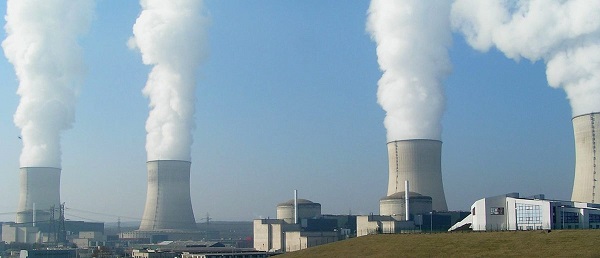Daily Caller
Shale Gas And Nuclear Set To Power The US Into The Future


From the Daily Caller News Foundation
By David Blackmon
Shale natural gas played the lion’s share of the role in lowering U.S. emissions to levels not seen since the early 1990s by enabling power generation companies to displace coal-fired power plants with combined cycle gas plants. This led to a situation during the first Donald Trump presidency in which the U.S. was the only western country which had met its commitments under the Paris Climate Accords, even though President Trump had ended America’s participation in that compact.
While countries like Canada, the UK, Australia, and those in the European Union continue their obsession with intermittent power sources like wind and solar, the United States has been blessed with one powerful alternative for cutting emissions and is set to go full speed in pursuit of another in the coming days.
That first alternative is natural gas produced from the major U.S. shale plays. As the Statistical Review of World Energy reported last year, no energy source in world history has ever been scaled up as rapidly as the domestic US industry has achieved with shale gas.
Shale has grown faster than wind, faster than solar, and faster than even Indonesian coal. Faster than anything before it in recorded history. This rapid scaling, combined with the immensity of the recoverable resource itself has facilitated massive reductions in carbon emissions not just at home, but also abroad.
At home, shale natural gas played the lion’s share of the role in lowering U.S. emissions to levels not seen since the early 1990s by enabling power generation companies to displace coal-fired power plants with combined cycle gas plants. This led to a situation during the first Donald Trump presidency in which the U.S. was the only western country which had met its commitments under the Paris Climate Accords, even though President Trump had ended America’s participation in that compact.
Internationally, the rapid expansion of the U.S. liquefied natural gas export industry is now helping enable importing countries across the globe to meet their own commitments. The immensity of the American resource ensures such results can continue to be achieved for decades to come.
The second power source related to which America is poised for explosive growth is a long-existing one that has been woefully underutilized for decades now: Nuclear. The Deseret News reports that the White House is preparing a set of four executive orders for the President’s signature in the coming days designed to jump start American dominance in this crucial energy sector.
“We are trying to knock things over that we can that are regulatory,” Energy Secretary Chris Wright told the House Appropriations Committee in a May 7 hearing and reported by Energy Intelligence. “There will be catalyzing regulatory events to bring” in “tens of billions of dollars” in private capital, “mostly from hyperscalers.”
Respected energy analyst and writer Robert Bryce was able to obtain a draft of one of the orders this week. Writing in his Substack newsletter, Bryce says the draft order “begins by pointing out that the US is losing the race to deploy new reactors and that China has announced plans to: ‘Bring 200 new gigawatts of nuclear power online by 2035, at which point its total nuclear output will more than double that of the United States. Further, as American development of new reactor designs has waned, 87% of nuclear reactors installed worldwide since 2017 are based on Russian and Chinese designs. These trends cannot continue. Swift and decisive action is required to jump-start America’s nuclear renaissance and ensure our national and economic security by increasing fuel availability, enabling research and development, and preparing our workforce.”
Obviously, jump-starting a fairly moribund industry is a stretch goal for the Trump administration, especially considering that the Nuclear Regulatory Commission has permitted just 5 new nuclear plants since 1978, only two of which were ultimately built and placed into service. But the reality facing the U.S. and the rest of the international community is that, if getting to net zero by any year in the future is truly an imperative, there is little other choice but to focus on a rapid, massive nuclear expansion. Intermittent, weather-dependent generation simply cannot get that job done.
Fortunately, it’s a reality that Trump and key advisors like Sec. Wright fully grasp. In a keynote speech delivered in Poland last month, Wright said, “The two biggest ‘climate solutions’ in the coming decades are the same as they were in the last two decades, natural gas and nuclear, for the simple reason that they work.”
He isn’t wrong, and the Trump administration is focused on ensuring the U.S. maximizes the benefits from both of these key energy engines both at home and abroad.
David Blackmon is an energy writer and consultant based in Texas. He spent 40 years in the oil and gas business, where he specialized in public policy and communications.
Daily Caller
‘There Will Be Very Serious Retaliation’: Two American Servicemen, Interpreter Killed In Syrian Attack


From the Daily Caller News Foundation
Two U.S. Army soldiers and an American civilian interpreter were killed in a Saturday attack in Syria, the Department of War announced.
Sean Parnell, chief spokesman for the Pentagon, announced the three deaths in a statement posted to X, adding that three others were wounded. The attack occurred as the U.S. soldiers were conducting a “key leader engagement,” Parnell stated.
The soldiers’ mission was “in support of on-going counter-ISIS/counter-terrorism operations in the region,” Parnell wrote. The attack occurred in an area Syrian President Ahmed al-Sharaa does not have control, Fox News reported, citing a Pentagon official.
Dear Readers:
As a nonprofit, we are dependent on the generosity of our readers.
Please consider making a small donation of any amount here.
Thank you!
“The soldiers’ names, as well as identifying information about their units, are being withheld until 24 hours after the next of kin notification,” he continued. “This attack is currently under active investigation.”
Secretary of War Pete Hegseth said in a Saturday statement posted on X that the “savage” who perpetrated the attack was “killed by partner forces.”
“Let it be known, if you target Americans — anywhere in the world — you will spend the rest of your brief, anxious life knowing the U.S. will hunt you, find you, and ruthlessly kill you,” Hegseth wrote.
U.S. and Syrian forces came under attack Saturday amid a joint patrol near Palmyra, The New York Times reported, citing Syrian state news agency SANA. U.S. Central Command also confirmed the deaths in a Saturday X post, but noted additional updates about the incident will be provided as they become available.
President Trump responded to the attack on Truth Social:
We mourn the loss of three Great American Patriots in Syria, two soldiers, and one Civilian Interpreter. Likewise, we pray for the three injured soldiers who, it has just been confirmed, are doing well. This was an ISIS attack against the U.S., and Syria, in a very dangerous part of Syria, that is not fully controlled by them. The President of Syria, Ahmed al-Sharaa, is extremely angry and disturbed by this attack. There will be very serious retaliation. Thank you for your attention to this matter!
Daily Caller
US Supreme Court Has Chance To End Climate Lawfare


From the Daily Caller News Foundation
All eyes will be on the Supreme Court later this week when the justices conference on Friday to decide whether to grant a petition for writ of certiorari on a high-stakes climate lawsuit out of Colorado. The case is a part of the long-running lawfare campaign seeking to extract billions of dollars in jury awards from oil companies on claims of nebulous damages caused by carbon emissions.
In Suncor Energy (U.S.A.) Inc., et al. v. County Commissioners of Boulder County, major American energy companies are asking the Supreme Court to decide whether federal law precludes state law nuisance claims targeting interstate and global emissions. This comes as the City and County of Boulder, Colo. sued a long list of energy companies under Colorado state nuisance law for alleged impacts from global climate change.
The Colorado Supreme Court allowed a lower state trial court decision to go through, improbably finding that federal law did not preempt state law claims. The central question hangs on whether the federal Clean Air Act (CAA) preempts state common law public nuisance claims related to the regulation of carbon emissions. In this case, as in at least 10 other cases that have been decided in favor of the defendant companies, the CAA clearly does preempt Colorado law. It seems inevitable that the Supreme Court, if it grants the cert petition, would make the same ruling.
Dear Readers:
As a nonprofit, we are dependent on the generosity of our readers.
Please consider making a small donation of any amount here.
Thank you!
Such a finding by the Supreme Court would reinforce a 2021 ruling by the Second Circuit Appeals Court that also upheld this longstanding principle of federal law. In City of New York v. Chevron Corp. (2021), the Second Circuit ruled that municipalities may not use state tort law to hold multinational companies liable for climate damages, since global warming is a uniquely international concern that touches upon issues of federalism and foreign policy. Consequently, the court called for the explicit application of federal common law, with the CAA granting the Environmental Protection Agency – not federal courts – the authority to regulate domestic greenhouse gas emissions. This Supreme Court, with its 6-3 conservative majority, should weigh in here and find in the same way.
Boulder-associated attorneys have become increasingly open to acknowledging the judicial lawfare inherent in their case, as they try to supplant federal regulatory jurisdiction with litigation meant to force higher energy prices rise for consumers. David Bookbinder, an environmental lawyer associated with the Boulder legal team, said the quiet part out loud in a recent Federalist Society webinar titled “Can State Courts Set Global Climate Policy. “Tort liability is an indirect carbon tax,” Bookbinder stated plainly. “You sue an oil company, an oil company is liable. The oil company then passes that liability on to the people who are buying its products … The people who buy those products are now going to be paying for the cost imposed by those products.”
Oh.
While Bookbinder recently distanced himself from the case, no notice of withdrawal had appeared in the court’s records as of this writing. Bookbinder also writes that “Gas prices and climate change policy have become political footballs because neither party in Congress has had the courage to stand up to the oil and gas lobby. Both sides fear the spin machine, so consumers get stuck paying the bill.”
Let’s be honest: The “spin machine” works in all directions. Make no mistake about it, consumers are already getting stuck paying the bill related to this long running lawfare campaign even though the defendants have repeatedly been found not to be liable in case after case. The many millions of dollars in needless legal costs sustained by the dozens of defendants named in these cases ultimately get passed to consumers via higher energy costs. This isn’t some evil conspiracy by the oil companies: It is Business Management 101.
Because the climate alarm lobby hasn’t been able to force its long-sought national carbon tax through the legislative process, sympathetic activists and plaintiff firms now pursue this backdoor effort in the nation’s courts. But their problem is that the law on this is crystal clear, and it is long past time for the Supreme Court to step in and put a stop to this serial abuse of the system.
David Blackmon is an energy writer and consultant based in Texas. He spent 40 years in the oil and gas business, where he specialized in public policy and communications.
-

 Alberta11 hours ago
Alberta11 hours agoThe Recall Trap: 21 Alberta MLA’s face recall petitions
-

 Digital ID2 days ago
Digital ID2 days agoCanada considers creating national ID system using digital passports for domestic use
-

 Alberta2 days ago
Alberta2 days agoHere’s why city hall should save ‘blanket rezoning’ in Calgary
-

 Fraser Institute2 days ago
Fraser Institute2 days agoClaims about ‘unmarked graves’ don’t withstand scrutiny
-

 Business2 days ago
Business2 days agoToo nice to fight, Canada’s vulnerability in the age of authoritarian coercion
-

 Business2 days ago
Business2 days agoUNDRIP now guides all B.C. laws. BC Courts set off an avalanche of investment risk
-

 Fly Straight - John Ivison1 day ago
Fly Straight - John Ivison1 day agoMPs who cross the floor are dishonourable members
-

 Energy2 days ago
Energy2 days agoMeet REEF — the massive new export engine Canadians have never heard of









